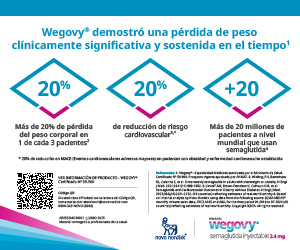Therapeutic approach in people with type 2 prediabetes
Keywords:
prediabetes, therapeutic approachAbstract
Pre-Type 2 Diabetes (PDM2) is an intermediate stage between normal glucose levels and those considered in the diagnosis of DM2. Recently, a Committee of Experts of the SAD published an update of the diagnostic criteria for PDM2. The American Diabetes Association recommends a screening for DM2 or PDM2 every 3 years in all adults over 35 years of age, regardless of the risk factors present, using fasting or 2-hour postload glucose, as well as HbA1c.
In 2018, a population screening published in the context of the Nhanes study determined a percentage of diagnosis by fasting glucose of 28.3%, HbA1c of 21.7% and 2-hour postload glucose of 13.3%. In those diagnosed with PDM2, annual monitoring of progression to DM2 is recommended1. The pathophysiological alterations of PDM2 are similar to those of T2D, the most important being, as we know, hepatic and peripheral insulin resistance, with impacts on fasting and postprandial glycemia respectively. Insulin secretion failure is the other fundamental pathophysiological component, present with a fasting glycemia level greater than 100 mg%.
The classic complications of DM2, both macro and microangiopathic, may be present in PDM2. Taking into account the pathophysiology and complications, PDM2 phenotypes can be established, which will influence the therapeutic intervention to be used2. Lifestyle changes (LSC), diet therapy and physical activity, carried out in several studies for 3 to 5 years, and which intensified this intervention vs. usual interventions, have been shown to significantly decrease the progression to DM2 from PDM2. This favorable impact was maintained in the post-study follow-up, which was extended to 15 or 30 years according to different studies such as the Diabetes Prevention Program or the Da Qing.
In general, CEVs did not modify the risk of micro or macrovascular complications in the post-study follow-up, except in individuals who achieved a remission of PDM2 to normoglycemia3. This opens the way for therapeutic intervention with drugs in those patients who persist in the state of PDM2, for which multiple studies using pharmacotherapy in PDM2 have been published. Metformin has shown less efficacy than CEVs in preventing progression to T2D, while pioglitazone has shown greater effectiveness than CEVs. Studies have also been published with iSGLT2 and ARGLP, where personalized medicine can begin to play an essential role4.
References
I. Menke A, Casagrande S, Cowie CC. Contributions of A1c, fasting plasma glucose, and 2-hour plasma glucose to prediabetes prevalence: NHANES 2011-2014. Ann Epidemiol 2018;28(10): 681-685.e2. doi: 10.1016/j.annepidem.2018.07.012.
II. Ali MK, Bullard KMK, Saydah S, Imperatore G, Gregg EW. Cardiovascular and renal burdens of prediabetes in the USA: analysis of data from serial cross-sectional surveys, 1988-2014. Lancet Diabetes Endocrinol 2018;6(5):392-403. doi:10. 1016/S2213-8587(18)30027-5.
III. Goldberg RB, Orchard TJ, Crandall JP, et al; Diabetes Prevention Program Research Group. Effects of long-term metformin and lifestyle interventions on cardiovascular events in the Diabetes Prevention Program and its outcome study. Circulation 2022;145(22):1632-1641. doi:10. 1161/CIRCULATIONAHA.121.056756.
IV. Wareham NJ. Personalised prevention of type 2 diabetes. Diabetologia 2022 Nov;65(11):1796-1803. doi: 10.1007/s00125-022-05774-7.
Downloads
Published
Issue
Section
License
Copyright (c) 2024 on behalf of the authors. Reproduction rights: Argentine Society of Diabetes

This work is licensed under a Creative Commons Attribution-NonCommercial-NoDerivatives 4.0 International License.
Dirección Nacional de Derecho de Autor, Exp. N° 5.333.129. Instituto Nacional de la Propiedad Industrial, Marca «Revista de la Sociedad Argentina de Diabetes - Asociación Civil» N° de concesión 2.605.405 y N° de disposición 1.404/13.
La Revista de la SAD está licenciada bajo Licencia Creative Commons Atribución – No Comercial – Sin Obra Derivada 4.0 Internacional.
Por otra parte, la Revista SAD permite que los autores mantengan los derechos de autor sin restricciones.




























